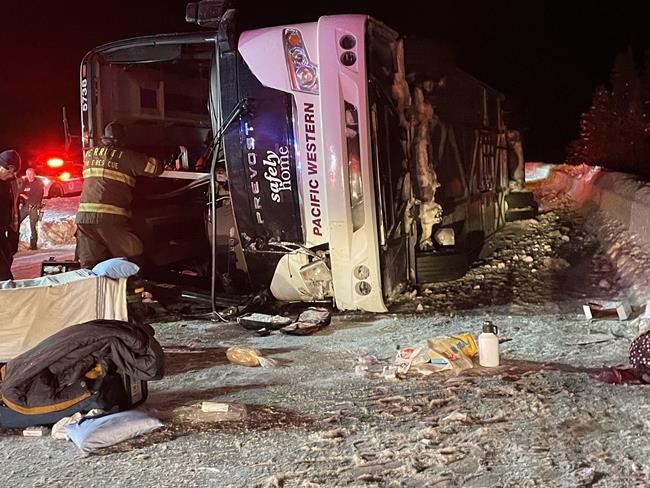KELOWNA, B.C. — An RCMP officer who interviewed survivors of the deadly Christmas Eve bus crash near Merritt, B.C., says it's time for passengers to throw out their false sense of security on buses and buckle up.
"I think there's a misconception that, because the buses are so large that if they get into a crash, they're so high up, they're going to be OK," Const. James Ward said in an interview Thursday.
"But that's not the event, as we've seen here, if the bus is to flip over."
RCMP investigators said in a statement that the bus was travelling west from Kelowna towards Merritt when it went off the road, crossed the median and flipped onto its side, coming to rest in the eastbound lanes.
Four people died and dozens were injured. Police have said they suspect extremely icy road conditions played a role.
The statement said the bus, operated by Alberta-based Ebus, had seatbelts but "unfortunately it appears the majority of passengers were not wearing them."
"I do know from speaking to some of the victims that the ones that were wearing seatbelts, the majority of them received minor injuries," Ward said in the interview. "The ones not wearing seatbelts all received significant injuries."
Ward said he is calling for a culture shift that reinforces the importance of buckling up on buses that goes beyond law enforcement.
"As the law stands, if the seat is equipped with a seatbelt, you're supposed to wear it. Unfortunately, trying to enforce that is next to impossible," Ward said.
He said bus drivers don't have enforcement powers, and police often aren't able to see inside a bus while it is moving.
"The law is only in effect if the vehicle is in motion, so if we pull over a bus and we walk on it to audit it, well, by virtue of the bus being stopped, the seatbelt law is no longer in effect," he said.
Instead, Ward said, a potential solution would be for bus drivers, like flight attendants, to make sure everyone is strapped in before the vehicle starts moving.
Bus safety advocate Gary Lillico said he has been pushing the issue of seatbelts for years.
He launched a petition in 2018 calling for Transport Canada to install three-point lap and shoulder seatbelts on every Canadian school bus and legally require children to wear them while on board.
“It’s just a couple of seconds to prevent injury and possibly save a life," he said in an interview. "To me, I can’t see how anybody would not want to wear a seatbelt."
Lillico, a former school bus driver, said he had met with paramedics, firefighters, police, doctors, emergency room staff and teachers to discuss the importance of wearing seatbelts.
“I never really met anybody that doesn’t advocate (for wearing seatbelts) except for a couple of trolls on one of the Facebook pages, but that’s about it. It’s a bit of a no-brainer,” he said.
— By Brieanna Charlebois and Nono Shen in Vancouver
This report by The Canadian Press was first published Dec. 29, 2022.
The Canadian Press



